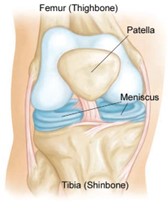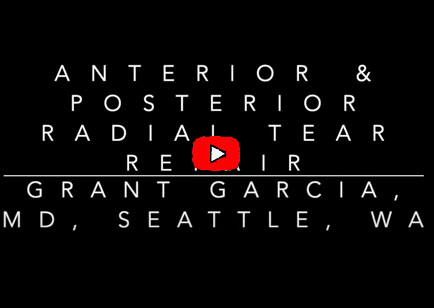Meniscus Repair: Insights from an Orthopedic Surgeon
Introduction
The meniscus, a crucial component of the knee joint, often sustains injuries that can lead to pain, swelling, and functional limitations. In this comprehensive webpage, I will share my expertise on meniscus repair, providing valuable insights into the background information, types of tears, indications for surgery, surgical techniques, postoperative outcomes, and the pivotal role of physical therapy in the recovery process.

Background Information
Understanding the Meniscus:
The meniscus is a wedge-shaped cartilaginous structure situated within the knee joint. It consists of two C-shaped structures: the medial meniscus on the inner side of the knee and the lateral meniscus on the outer side. The meniscus serves as a shock absorber, distributing forces evenly across the knee, and provides stability during various movements. Torn meniscus causes pain, swelling, stiffness, catching or locking sensation in your knee making you unable to move your knee through its complete range of motion.
Dr. Garcia demonstrates his inside-out meniscus repair technique for complex tears.
Types of Meniscus Tears:
Meniscus tears vary in type and severity, and they can be classified into three primary categories:
- Radial Tears: These tears extend from the outer edge of the meniscus towards the inner edge in a straight line. Radial tears are more amenable to repair, especially when located in the outer third of the meniscus.
- Horizontal Tears: Horizontal tears run parallel to the meniscus and are less likely to heal on their own due to limited blood supply. They often require surgical intervention.
- Complex Tears: Complex tears combine elements of radial, horizontal, and other tear patterns, making them challenging to repair. The choice of treatment for complex tears depends on their specific characteristics.
Causes of Meniscus Tears:
Meniscus tears can result from various factors, including:
- Trauma: Sudden twisting, pivoting, or direct impact injuries can lead to meniscus tears, making athletes and active individuals particularly susceptible.
- Degenerative Changes: Over time, the meniscus can undergo degenerative changes, increasing the risk of tears, especially in older individuals.
- Age: While meniscus tears can occur at any age, they are more common in individuals over 30 years old.
Indications for Meniscus Repair
Not all meniscus tears require surgery, and the decision to proceed with meniscus repair is based on several factors, including:
- Tear Location: Tears located in the outer third of the meniscus, where blood supply is better, have a higher potential for healing. Repair is more likely in such cases.
- Tear Type: The type of tear, such as radial or horizontal, plays a significant role in the decision-making process. Radial tears and vertical tears are generally more suitable for repair than complex horizontal tears.
- Patient Age: Younger patients tend to have better healing potential, making repair a more favorable option for this age group.
- Activity Level: Patients who engage in physically demanding activities or sports may benefit from meniscus repair to restore knee stability and function.
- Associated Injuries: The presence of concurrent knee injuries, such as ligament tears, may influence the decision to repair the meniscus.
Dr. Garcia demonstrates his complex repair of a rare anterior and posterior radial meniscus tear in a high level soccer player
Surgical Techniques
Meniscus repair surgery has evolved significantly over the years, with advancements in minimally invasive techniques. As an orthopedic surgeon, I carefully assess each patient's unique case to determine the most appropriate surgical approach. Here are some common techniques used in meniscus repair:
1. Arthroscopic Surgery:
Most meniscus repairs are performed arthroscopically. This minimally invasive approach involves making small incisions around the knee joint and utilizing specialized instruments and a camera (arthroscope) for visualization. Arthroscopy allows for a detailed examination of the meniscus and surrounding structures.
2. Suturing Techniques:
- Inside-Out Technique: In this method, sutures are placed on the inner side of the meniscus and then pulled out through small incisions on the outer side. This technique is particularly suitable for complex tears and provides strong fixation.
- Outside-In Technique: Suturing from the outer edge of the meniscus toward the inner side is less commonly used today but may be appropriate for specific tear patterns.
- All-Inside Technique: This newer approach uses specialized devices and instruments to place sutures entirely within the joint, eliminating the need for incisions on the outer side of the knee. It offers the advantage of being less invasive and is gaining popularity for certain tear types.
3. Meniscal Transplantation:
In cases where the meniscus is extensively damaged and cannot be repaired, meniscal transplantation may be considered. This procedure involves replacing the damaged meniscus with a donor meniscus graft. It is typically reserved for younger patients with significant meniscal loss. See Dr. Garcia’s section on meniscal transplant for more information on this unique procedure.
Horizontal meniscus repair in a high level soccer player
Outcomes and Recovery
Successful meniscus repair can significantly alleviate pain and restore knee function, but outcomes can vary depending on several factors:
- Healing Time: The meniscus has limited blood supply, affecting its capacity to heal. Tears located closer to the outer edge (vascular zone) have a higher chance of successful healing compared to tears in the inner zone.
- Rehabilitation: Postoperative rehabilitation plays a pivotal role in achieving a successful recovery. It typically involves a carefully structured physical therapy program.
- Return to Activities: The timeline for returning to regular activities or sports varies from patient to patient. It depends on the type of repair, individual progress, and recommendations from the surgical team and physical therapist.
- Long-Term Outcomes: When meniscus repair is successful, it can provide significant pain relief and functional improvement. Moreover, it may help delay or prevent the development of osteoarthritis in the affected knee.
- Complications: Although complications are relatively rare, they can include infection, persistent pain, stiffness, or re-tear of the meniscus. These risks are discussed with the patient before surgery, and measures are taken to minimize them.
Dr. Garcia demonstrates his technique for complex anterior meniscus repair
Complex vertical and horizontal meniscus repair
Physical Therapy
Physical therapy is an integral component of the meniscus repair recovery process. It is essential for helping patients regain strength, range of motion, and function in the repaired knee. Here's a closer look at the role of physical therapy:
- Pain Management: In the early stages of recovery, physical therapists employ various techniques to manage pain and reduce swelling. These may include ice, electrical stimulation, and manual therapy.
- Range of Motion: Restoring full range of motion in the knee is a top priority. Gentle stretching exercises are introduced gradually to improve flexibility while protecting the repaired meniscus.
- Strengthening Exercises: Weakness in the muscles surrounding the knee can lead to instability and improper joint mechanics. Physical therapists focus on strengthening the quadriceps, hamstrings, and calf muscles to enhance knee stability.
- Proprioception and Balance: Meniscus tears can disrupt the knee's proprioception (awareness of joint position). Balance and proprioception exercises help patients regain joint stability and prevent future injuries.
- Functional Activities: As the patient progresses, physical therapists incorporate functional activities and sports-specific drills to prepare individuals for a safe return to their desired activities.
Meniscus Repair with new Fiberstitch
In Conclusion
Meniscus repair is a vital procedure that can make a substantial difference in the lives of patients suffering from meniscus tears. As an orthopedic surgeon, I have witnessed the positive impact of this surgery on countless individuals. It is essential for patients to be informed about the options available to them, work closely with their healthcare team, and commit to a thorough rehabilitation process to achieve the best possible outcome. With advancements in surgical techniques and the dedicated efforts of both surgeons and physical therapists, meniscus repair continues to offer hope and healing to those in need.


















